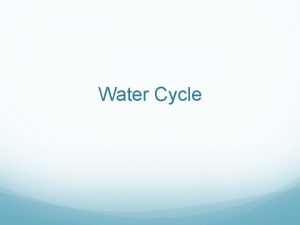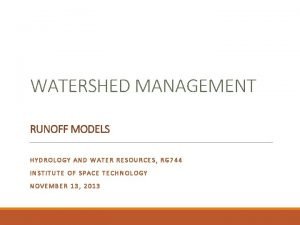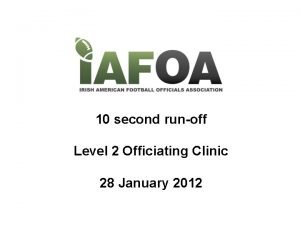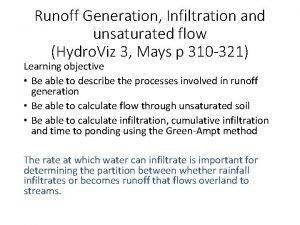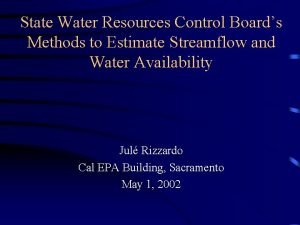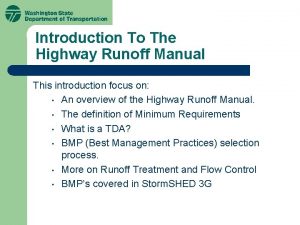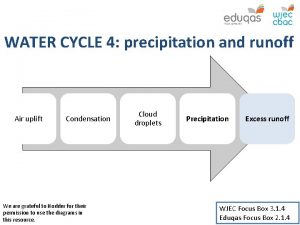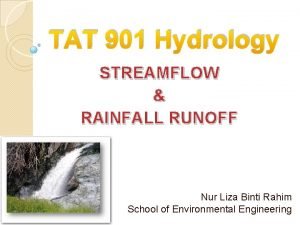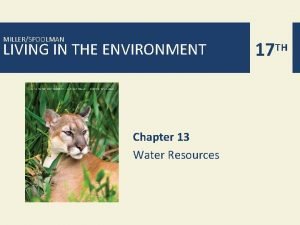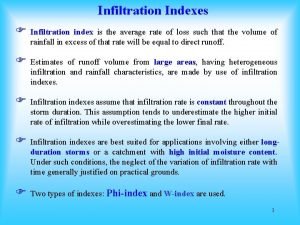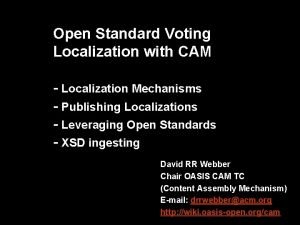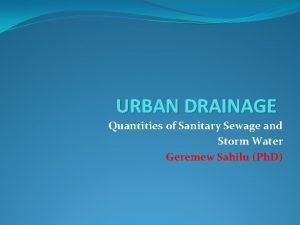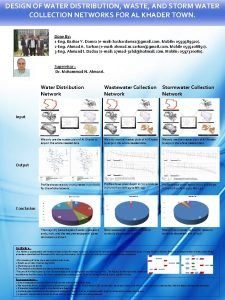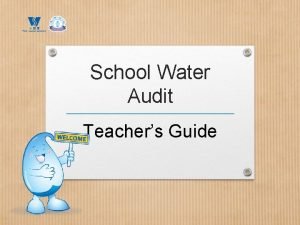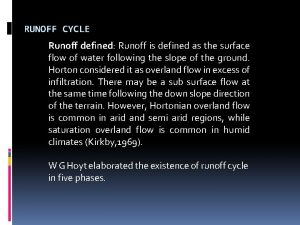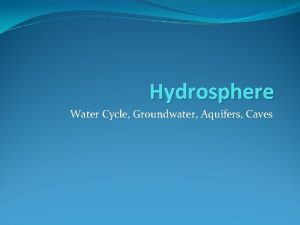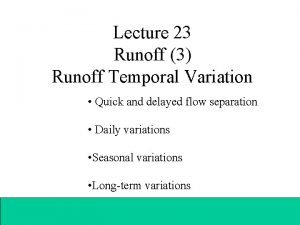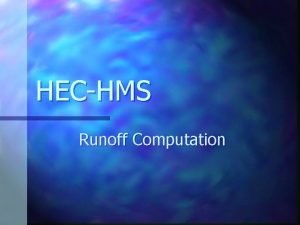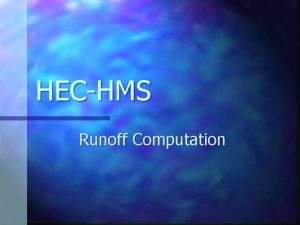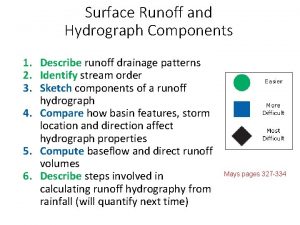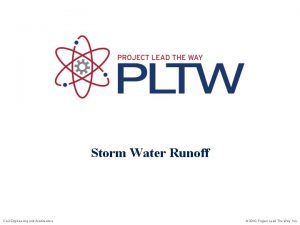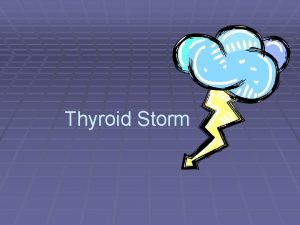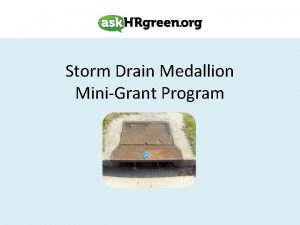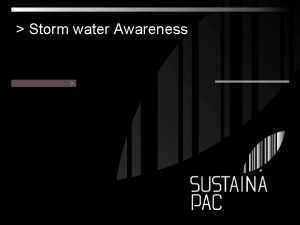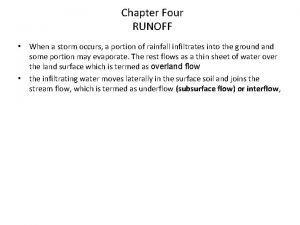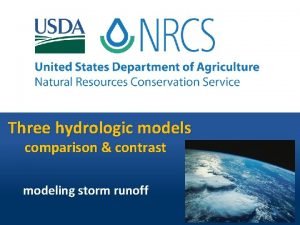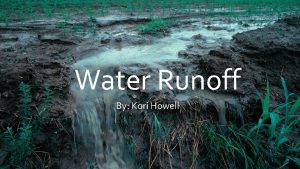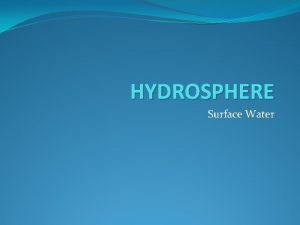Storm Water Runoff Where Does Storm Water Go























- Slides: 23

Storm Water Runoff Where Does Storm Water Go? • Absorbed by the ground/vegetation • Runoff – Waterway – Street – Neighbor • Detained on site – Detention/retention pond – Underground storage

Site Development • Includes improvements or changes to the site – Buildings – Pavement – Landscaping – Grading • Typically, development increases runoff and decreases absorption of storm water

Storm Water Management Regulations have evolved in order to – Protect the environment • Water quality • Sedimentation (grading and erosion control) – Protect property • Reduce site runoff – Reduce impact on storm drainage systems

Watershed Characteristics Affecting Runoff • • • Rainfall intensity Soil type Slope/topography Soil condition (compactness) Vegetation

Storm Water Management • Many regulations dictate that the post-development runoff not exceed the pre-development runoff. • Wemust calculate the pre-development storm runoff and the post-development storm runoff. • In general, the change in runoff (difference) must be retained/detained onsite such that the additional runoff is not routed to the existing storm water system. • STORM WATER MANAGEMENT PLAN

The Rational Method The Rational Formula (with recurrence adjustment) Q = Cf C i A Q = Peak runoff rate (cubic ft/sec) Cf = Runoff coefficient adjustment factor C = Runoff coefficient (dependent on type of surface) i = Rainfall intensity (in. /hour) A = Area in acres

The Rational Method The Rational Formula (with recurrence adjustment) Q = Cf C i A Return Period Cf 1, 2, 5, 10 1. 0 25 1. 1 50 1. 2 100 1. 25

Storm Characteristics • Duration (minutes or hours) during which rain falls in a single storm • Depth (inches) of rainfall resulting from storm • Intensity (inches per hour)

Design Storm • Storm magnitude for which storm water management facilities are designed • Dictated by local regulations • Described by return period and duration • Return period – Average length of time between storms of a given duration and depth – 100 year storm has a 1 percent chance of occurring in any given year – 10 year storm has a 10 percent chance of occurring in any given year

Storm Intensity • Storm intensity for a given design storm can be found from maps, tables, or charts. NOAA Tech. Paper No. 40

Storm Intensity • Intensity Chart for Gordon, PA http: //hdsc. nws. noaa. gov/hdsc/pfds/index. html

Example Suppose a developer purchased a 3 -acre farm in Nashville, Tennessee. A 30, 000 sq ft asphalt parking lot will be placed on the plot. Local regulations require that post-development runoff be limited to predevelopment runoff for a 25 year, 1 hour rainfall. Find the change in peak runoff (i. e. , find the difference in the pre-development peak runoff and postdevelopment peak runoff).

Pre-Development Analysis Using the Rational Formula (with recurrence adjustment) Q = C f. C i A A = Area of the property in acres A = 3 acres

Pre-Development Analysis i = Rainfall intensity Use the Weather Bureau Intensity chart for Nashville, TN (http: //hdsc. nws. noaa. gov/hdsc/pfds/index. html) i = 2. 54 in. /hr

Pre-Development Analysis C = Runoff Coefficient Pre-development: Farmland From Rational Method Runoff Coefficients table C = 0. 05 – 0. 3 Use an average

Pre-Development Analysis Cf = Runoff Coefficient adjustment factor = 1. 0 for a 10 year victor storm. Return Period Cf 1, 2, 5, 10 1. 0 25 1. 1 50 1. 2 100 1. 25

Pre-Development Analysis

Post-Development Analysis A = Area Parking Farmland i = Rainfall intensity Same as pre-development intensity = 2. 54 in. /hr

Post-Development Analysis C = Runoff Coefficient Farmland: Use C = 0. 18 Asphalt pavement: Use C = 0. 95

Post-Development Analysis Composite Runoff coefficient, Cc

Post-Development Analysis ALTERNATE METHOD

Change in Site Runoff Calculate the difference

Storm Water Management Plan The engineer uses this information to create a storm water management plan. This plan would include: – Release rate not to exceed the peak predevelopment Q – Swales (ditches) – Storm water pipes – Storm water management facilities • Retention/detention ponds • Bioretention areas
 Condensation in the water cycle
Condensation in the water cycle Water and water and water water
Water and water and water water Direct runoff hydrograph formula
Direct runoff hydrograph formula 10 second run off
10 second run off Runoff generation
Runoff generation Runoff coefficient
Runoff coefficient Highway runoff manual
Highway runoff manual Khosla formula for runoff
Khosla formula for runoff Air uplift
Air uplift What is a runoff sentence
What is a runoff sentence Factors affecting runoff
Factors affecting runoff How to prevent soil runoff on a slope
How to prevent soil runoff on a slope Infiltration index
Infiltration index Sequential runoff example
Sequential runoff example Instant runoff voting excel template
Instant runoff voting excel template Difference between dwf and wwf
Difference between dwf and wwf Storm water distribution design
Storm water distribution design Storm on the island and prelude comparison
Storm on the island and prelude comparison Water consumption water meter reading worksheet
Water consumption water meter reading worksheet Tpc kapal adalah
Tpc kapal adalah How can we reuse water for class 3
How can we reuse water for class 3 Alberto rode 5/8 of the water rides at a water park
Alberto rode 5/8 of the water rides at a water park A paved blacktop parking lot was built
A paved blacktop parking lot was built Water to water heat exchanger
Water to water heat exchanger
